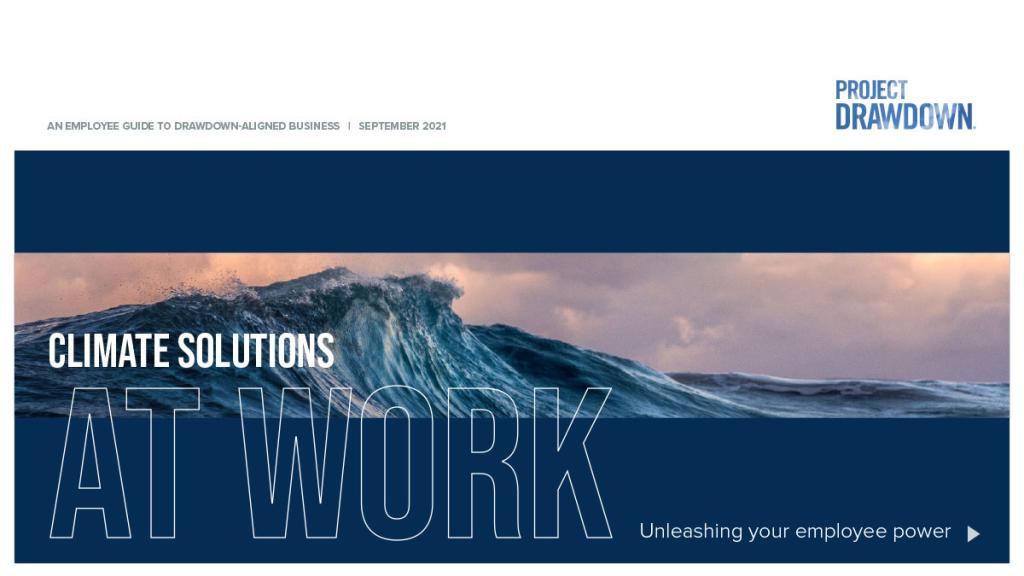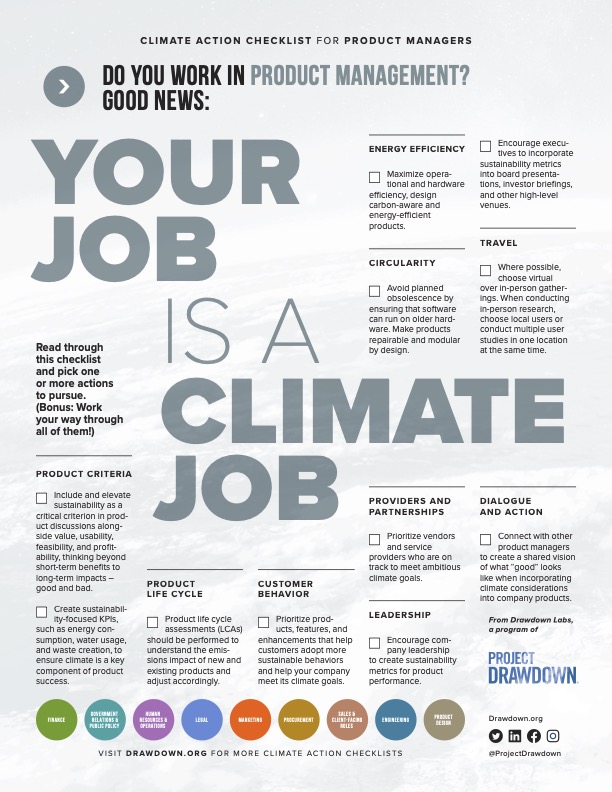Climate Solutions at Work
As a product manager, you may be tasked with conducting market research, developing product positioning, and defining customer success – weaving together business, technology, and user experience. Because you have touchpoints with many stakeholders throughout the product journey, you are well-positioned to effectively communicate the importance of comprehensive climate considerations and advocate for them. The products you manage should not only be usable, feasible, and profitable, but also sustainable, with the potential to advance your organization's climate goals and shift user or customer behavior.
Please keep in mind that the scope of your role, your company, and/or the industry in which it operates may make some actions more or less applicable. We recognize that product management may overlap with other product development roles; for more ideas, see the Product Design and Engineering action guides. We encourage you to explore the actions in all of the guides to see which are most relevant to you!
Lastly, have you used this or any of our Job Function Action Guides to make your job a climate job? If so, we want to hear about it! We encourage you to share your story with us by emailing labs@drawdown.org
To make your product management job a climate job:
Integrate climate impact into your product
Product criteria
- Incorporate and elevate sustainability as a key criterion in product discussions alongside value, usability, feasibility, and profitability.
- Is your product exacerbating or mitigating the climate crisis?
- The climate crisis does not affect everyone equally. Think beyond the short-term benefits of your product to its potential long-term impacts – good and bad – particularly for those communities most vulnerable to climate change. (Check out Spotify’s Ethics Assessment template for inspiration on how you might evaluate sustainability and equity for your products.)
- Create sustainability-focused KPIs, such as energy consumption, water usage, and waste creation, to ensure climate is a key component of product success.
- Adopt decision-making frameworks that incorporate climate impact as a primary consideration in all product-related decisions. (Check out this exploration of different frameworks for creating climate-friendly products.)
Prototyping
Product life cycle
- Conduct product life cycle assessments (LCAs) with the sustainability, procurement, design, manufacturing, and other teams to understand the greenhouse gas emissions impact of new and existing products and adjust accordingly. (LCAs are critical for understanding and thus reducing emissions from products because they can vary greatly across the supply chain and industries.)
- Collaborate with data teams to identify the most appropriate technology for product LCAs, allowing you and your team to find sustainable alternatives and track product usage data.
- Consider how climate risks may impact the manufacture, distribution, sale, and use of your product.
- Will climate-related supply chain disruptions, such as crop failures or material shortages, have an effect on your product?
- Work with the sustainability and public policy teams to understand how changing laws and policies may impact your product.
Customer behavior
- Prioritize products, features, and enhancements that help customers make sustainable behavior changes. For example, provide users with real-time information about their energy consumption as a result of using the product and suggest ways for them to reduce their impact.
- Survey and track customer interest in climate and sustainability. (This will assist you in developing a more compelling business case for implementing sustainability requirements.)
Prioritize energy savings and circularity
Energy consumption
- To reduce "bloat" (too many underutilized features and functionalities), clearly identify and communicate customer value throughout the product journey. This not only saves money and time but also reduces energy consumption from emissions-intensive manufacturing and data center usage. (On average, 80% of features in software products are rarely or never used, meaning the energy used to keep them functional is wasted.)
Energy efficiency
- When defining the product roadmap, integrate the following energy efficiency principles into feature prioritization and success indicators:
- Maximize operational and hardware efficiency.
- Design carbon-aware and energy-efficient products.
- Advocate for higher-quality and longer-lasting designs and materials.
- Keep in mind timing (time of day) and geographic context (where renewable energy is more abundant) as they relate to energy efficiency. Account for the fact that the carbon intensity of the grid varies throughout the day and across regions. (See also Google’s Carbon Free Energy 24/7 initiative and work to shift demand to when the grid is cleaner.)
Circularity
- For hardware and physical products, invest in infrastructure and services that enable circularity, such as take-back and recycling services (like HP) and marketplaces for refurbished products (like IKEA).
- If designing for take-back and recycling, keep in mind the complexities and ambiguity surrounding recycling. For more information, see this guidance.
- Develop sales models that reduce waste, like collaborative consumption (e.g. tool-sharing services).
- Avoid planned obsolescence:
- Ensure software can run on older hardware to extend the useful lifespan of end-user devices.
- Make products repairable (like Patagonia).
- Design for modularity (like Fairphone).
Evaluate providers and partnerships
- Prioritize vendors and service providers who have already set ambitious climate goals and are on track to meet them. (Confirm if the companies you work with have established science-based targets.)
- Include climate criteria in RFPs and RFIs when selecting suppliers and partners to assist in product development and delivery. For software products, this includes hosting, distribution, billing and payments, returns, customer communications, and so on. (Check out this list of climate-related due diligence questions you can ask your vendors.)
- Consider that if your company is a supplier to another company with its own sustainability goals, having a lower carbon impact will give you a competitive advantage.
Expand your product's climate impact, organization wide and beyond
- Connect with other product managers in your organization and other organizations to learn from one another, build capacity and knowledge around climate solutions, and develop a shared vision for what “good” looks like when integrating climate into your company's products. (Check out Climate Action.tech for resources.)
- Working with your organization's hiring managers and human resources team, revise existing job descriptions and recruiting practices to incorporate climate concerns into screening, interviews, and onboarding.
- Collaborate with your sales, marketing, and finance teams to include the social cost of carbon – a “carbon fee” – in product pricing and reinvest that additional revenue into accelerating company sustainability goals.
- Collaborate with the marketing team to ensure that all product branding, labeling, and advertising avoids greenwashing and is transparent about potential climate impacts and benefits. Use product marketing to educate your customers about climate change and its solutions.
- Educate your product development and engineering teams on the importance of incorporating sustainability into their designs, and consider bringing in relevant experts for workshops and presentations.
- Work with engineering teams to build sustainability into product architecture, like writing efficient code, minimizing stored data, and planning for data deletion.
Bring leadership along
- Volunteer to present and share resources on the fundamentals of sustainability and climate impact with leadership. (Project Drawdown's Climate Solutions 101 and Drawdown Roadmap for Business video are a good place to start!)
- Find an internal climate champion to lend weight to the decision to incorporate climate considerations into product management – ideally, someone higher up in your organization, such as the Chief Sustainability Officer, a climate-conscious executive in finance or operations, or even someone just a few levels above you. This individual might serve as an internal ally, reinforcing sustainability as a key measure of product success.
- How can you collaborate with this internal champion to connect product goals and strategies to larger, corporate-level sustainability goals?
- Encourage both your team and company leadership to create sustainability metrics for product performance and to incorporate these into board presentations, investor briefings, and other important executive-level venues.
Reassess team travel
- Reduce carbon-intensive business travel for you and your team by opting for virtual meetings. If you can, avoid flying and instead take a train or use another mode of transportation that emits fewer emissions.
- When conducting in-person research, opt for local users. If that’s not possible, conduct multiple user studies in a single geographic location at one time.
Foster dialogue and action
- Build capacity and knowledge by connecting with other product managers – and beyond – in your organization. Come together to brainstorm climate action steps (check out Project Drawdown's Discover page for ideas), share best practices, and raise your collective concern at team and all-staff meetings.
Ready to take action? Here are some questions and ideas to help you get started:
Take stock
Identify your company’s corporate sustainability and climate commitments, if any.
- Are these goals related to the objectives of the product management team?
- Can you incorporate the actions listed above into your company's, team's, or individual performance goals?
- Does your company have a goal to reduce Scope 3 emissions which include emissions from the use of its products?
- Are product managers incentivized to incorporate low-carbon and circular economy principles throughout the product development process?
- Is there a mandate or incentive in place from leadership to incorporate sustainability value commitments into all new product development?
- Can you start or join a green team or a climate employee resource group?
Make needed changes or reach out to someone else who can.
- What kind of decision-making authority do you have? Can you carry out these actions on your own, or do you need to consult with a manager or director?
- Are those with decision-making authority already on board with climate action? Is there anyone you might be able to engage and influence?
Test the waters by discussing your own interest in climate action with trusted colleagues and gauging their reactions. Consult power-mapping tools for help.
You don’t have to do it alone
Find others in your department who are climate-concerned. Join forces to demonstrate widespread support for incorporating climate action into products and across the organization. Consider writing a letter or petition to management or bringing up your concerns at an all-staff meeting.
Need help making the business case?
As owners of product strategy, product managers are uniquely positioned to drive sustainable innovation within a company. While product managers must balance many competing interests, sustainability is quickly becoming a top business priority for a variety of reasons, among them the ability to attract capital, conform with regulatory pressures, and, perhaps most importantly, meet increased customer demand. Customers and investors alike are citing sustainability as a key factor in decision-making. And they are not just saying it. In 2022, "socially responsible or sustainable products made up at least half of [recent] purchases" for three out of five customers, and three out of five investors consider sustainability when building their portfolios. Product managers are customer-focused and frequently see the future business landscape before many inside a company, and it is now more clear than ever that customers prioritize climate-friendly products.
Resources
Software
Design
Climate justice
Everyone has a role to play
The Drawdown Labs Job Function Action Guides will help employees understand how their roles are critical in addressing the climate crisis, as well as implement high-impact solutions and navigate key considerations for taking action inside the workplace.
Partnerships
and Community
Affairs
Please note: This graphic is illustrative of how different teams across a company must work together to achieve strong climate action. We encourage you to examine your organization’s own unique structure to determine how to best coordinate and integrate climate action across functions.


